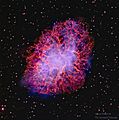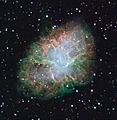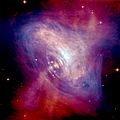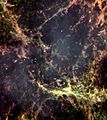Crab nebula
Quick facts for kids Crab nebula |
|
|---|---|
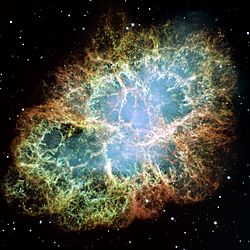
M1, the Crab nebula
|
|
| Observation data: J2000.0 epoch | |
| Type | Supernova remnant |
| Right ascension | 05h 34m 31.97s |
| Declination | +22° 00′ 52.1″ |
| Distance | 6.5 ± 1.6 kly (2.0 ± 0.5 kpc) |
| Apparent magnitude (V) | +8.4 |
| Apparent dimensions (V) | 420″ × 290″ |
| Constellation | Taurus |
| Physical characteristics | |
| Radius | 5.5 ly (1.7 pc) |
| Absolute magnitude (V) | −3.1 ± 0.5 |
| Notable features | Optical pulsar |
| Other designations | Messier 1, NGC 1952, Sharpless 244 |
| See also: Diffuse nebula, Lists of nebulae | |
The Crab Nebula is a famous cloud of gas and dust in space. It is found in the constellation of Taurus. This nebula is what is left over after a huge star exploded. This kind of explosion is called a supernova. The Crab Nebula is also known as Messier 1, or M1. It was the first object listed in a special catalog made by Charles Messier in 1758.
The nebula was first seen by John Bevis in 1731. But the supernova that created it was recorded much earlier. Chinese and Islamic astronomers saw this very bright supernova in the year 1054.
The Crab Nebula is about 6,500 light-years away from Earth. A light-year is how far light travels in one year. It is very big, about 11 light-years across. The nebula is still growing, expanding at about 1,500 kilometers (930 miles) every second. It is part of the Perseus Arm of our home galaxy, the Milky Way.
At the very center of the Crab Nebula is something called the Crab Pulsar. This is a tiny, super-dense star known as a neutron star. It is only about 28–30 kilometers (17–19 miles) wide. This spinning star sends out bursts of radiation, from powerful gamma rays to radio waves. It spins incredibly fast, about 30 times every second!
Scientists use the Crab Nebula to study other things in space. For example, in the 1950s and 1960s, they mapped the Sun's outer atmosphere, called the corona. They did this by watching how the Crab's radio waves passed through it. In 2003, they even measured the thickness of the atmosphere of Saturn's moon Titan. They did this by observing how Titan blocked X-rays coming from the nebula.
Contents
What is the Crab Nebula made from?
The Crab Nebula is the cloudy remains of a huge star that exploded. This explosion happened in the year 1054. The nebula is also called Messier 1 or M1. It was the first object listed in the Messier catalogue, a list of comet-like objects.
How much energy does the Crab Nebula have?
Scientists have studied the energy coming from the Crab Nebula. For a long time, they knew it was a very strong source of X-ray and gamma ray energy. These are types of light we cannot see. The energy levels were known to be very high, above 1012 eV.
But recent studies have shown that the energy levels are even higher than thought. Scientists found emissions at more than 100 GeV (gigaelectronvolts). This is 100 billion times more energetic than the light we can see with our eyes!
How did the Crab Nebula form?
The Crab Nebula was created by a very bright supernova explosion. This explosion is known as SN 1054. Chinese astronomers wrote about it in 1054 AD. The Crab Nebula itself was first seen by John Bevis in 1731.
Later, in 1758, Charles Messier also found the nebula while looking for a comet. He added it as the first item in his Messier catalogue of objects that look like comets. In 1848, the Earl of Rosse observed the nebula. He called it the Crab Nebula because his drawing of it looked like a crab.
In the early 1900s, scientists looked at old photos of the nebula taken years apart. They saw that it was getting bigger. By tracing its expansion backward, they figured out the nebula must have become visible about 900 years ago. This matched historical records from 1054. Chinese astronomers had written about a "guest star" that was so bright it could be seen during the daytime.
Because of its great distance, this "guest star" could only have been a supernova. This means a huge star ran out of fuel and collapsed, causing a massive explosion.
Recent studies of these old records show that the supernova probably appeared in April or early May of 1054. It became brightest by July, shining brighter than anything else in the night sky except the Moon. People could see the supernova with their naked eyes for about two years. Thanks to these detailed records from astronomers in Asia and the Middle East, the Crab Nebula was the first object in space to be linked to a supernova explosion.
Images for kids
-
Reproduction of the first depiction of the nebula by Lord Rosse (1844) (colour-inverted to appear white-on-black)
-
Image combining optical data from Hubble (in red) and X-ray images from Chandra X-ray Observatory (in blue).
-
Hubble image of a small region of the Crab Nebula, showing Rayleigh–Taylor instabilities in its intricate filamentary structure.
-
This sequence of Hubble images shows features in the inner Crab Nebula changing over a period of four months.
-
Chandra image showing Saturn's moon Titan transiting the nebula.
See also
 In Spanish: Nebulosa del Cangrejo para niños
In Spanish: Nebulosa del Cangrejo para niños



